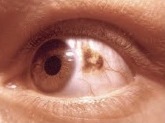
Photo from wikipedia
Dear Editor We read with interest the article by Demirel et al. [1] describing the role of optical coherence tomography angiography (OCTA) in pachychoroid spectrum diseases. In this study, the… Click to show full abstract
Dear Editor We read with interest the article by Demirel et al. [1] describing the role of optical coherence tomography angiography (OCTA) in pachychoroid spectrum diseases. In this study, the authors compared OCTAwith conventional dye angiography, which highlighted the usefulness and greater sensitivity of OCTA in detecting type 1 choroidal neovascularization (CNV) compared to conventional angiography. The pachychoroid spectrum of diseases includes central serous chorioretinopathy, pigment epitheliopathy, neovasculopathy, and polypoidal choroidal vasculopathy (PCV). [2] In the current study, the authors described one patient with polypoidal characteristics. In contrast, another series by Dansingani et al. [3] reported 18% of patients with pachychoroid diseases which exhibited polypoidal lesions. OCTA is an exciting new technology that promises to have a significant impact on the management of retinal diseases. We would like to point out, however, that currently, OCTA may not be sufficiently sensitive as a primary imaging modality to diagnose PCV because it can only detect PCV lesions in a proportion of eyes with established PCV. [4] In earlier studies, OCTA detected polyps in 36.2 to 55.3% of eyes where the diagnosis of PCV had been established using conventional diagnostic techniques, while the branching vascular network (BVN) was seen in 55.3 to 100% of eyes. [4–6] A recent study by De Carlo et al. [7] showed the sensitivity and specificity of OCTA in detecting PCV to be 43.9 and 87.1%, respectively. It is possible that some eyes in the pachychoroid spectrum of diseases may have PCV which are not detected using OCTA, and the results of OCTA scans must therefore be interpreted with caution. The current gold standard for diagnosis for PCV is indocyanine green angiography (ICGA), which enables both the polyps and the BVN to be reliably imaged [4, 8–10]. Though OCTA can provide new and useful information on the diagnosis and follow-up of PCV, it should currently be used as an adjunctive tool to ICGA. In summary, we congratulate Demirel and co-authors on their paper, which helps us to better understand the role of OCTA in the pachychoroid spectrum of disease.
Journal Title: Graefe's Archive for Clinical and Experimental Ophthalmology
Year Published: 2018
Link to full text (if available)
Share on Social Media: Sign Up to like & get
recommendations!